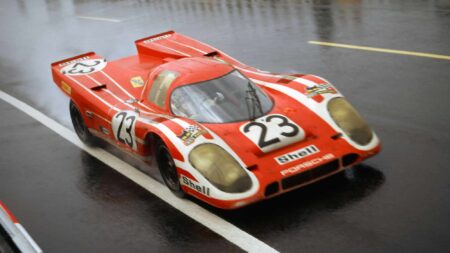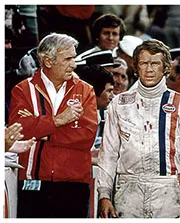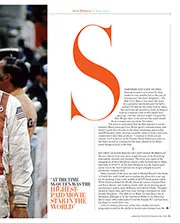“The week of Le Mans I called in there with Shambles [fellow Lotus 11 racer John Campbell-Jones] and we hung around the paddock like a couple of prostitutes outside a railway station, hoping to get a drive. I talked my way into Maurice Charles’ D-type, did a couple of laps in practice, but early in the race Maurice stuffed it at Maison Blanche.”
In the aftermath of the Suez crisis David’s deal with Esso had ended, and he began a long relationship with BP. The first Lotus 11 had been dark green with red and white stripes, but since then David’s cars have always worn the distinctive colour which he calls BP green. To everybody else it’s “Piper green”.
“In 1959 I joined up with Bob Bodle, who had a garage business at Dorchester-on-Thames. We bought two Lotus 16 single-seaters and a Lotus 15, with 1.5 and 2.5 Climax engines, so we could swap the engines around and run in sports cars, F2 and F1. That 15 was probably, for its day, the best sports car I ever drove. In one of the heats at Roskilde, up in Denmark, I beat Moss and Brabham in Cooper Monacos. And I led Roy Salvadori at Aintree until my throttle was jammed open by a pair of tin-snips I’d left on top of the engine.” He qualified ninth for the TT at Goodwood, but had a big accident at Madgwick when a tyre blew and he was briefly hospitalised with head injuries. He ran one of the 16s in F2 form in the British Grand Prix, and in full 2.5-litre form for the October Brands Hatch, when he won and broke the circuit’s F1 lap record.
That winter David took both Lotus 16s to New Zealand, travelling alone as usual and acting as his own mechanic, and finished a fine second to Jack Brabham in the Lady Wigram Trophy. “The idea was to sell one or both cars at the end of the series, but front-engined cars were no longer fashionable. Frank Shuter offered to swap the Alfa Romeo Bimotore for one – that’s a deal I should have done.” Back in Europe the Lotuses were raced throughout 1960, and in the British GP he finished 12th, but the days of the privateer in F1 were clearly numbered.

Rocking Oulton Park in a Ferrari 412 P in 1968
Getty Images
Keen to return to the nomadic life, David downgraded to Formula Junior for 1961. He bought the first customer Lotus 20, and put it together in the garden of a house in Hampstead where he was staying with friends. “I got an 850 Mini, put a towbar on the back, took the seats out so I could get the tools and a spare engine inside, and made a small trailer. I was off on the Continent again, living on the start money and prize money, racing almost every weekend, sleeping in the open.
“Jo Siffert also had an FJ Lotus, so we went around together, and did some wheeling and dealing in old racing cars too. We finished first and second at Cesenatico, on the Adriatic, then I was third at Vallelunga a week later, and among other places we did Montlhéry, Lake Garda, Chimay, Roskilde, Caserta, Messina and Zandvoort. At the first sniff of any start money we’d be off like a robber’s dog. We were racing at Avus in East Berlin when we heard there was an autobahn race coming up in Dresden. That was deep in East Germany, and we only had permission to travel along the motorway, which was very rough and full of potholes. You couldn’t turn off anywhere. Dresden was still pretty much flattened since the war, and there was very little going on. But I won there, got some beautiful trophies, and lots of money: unfortunately it was all in East German marks, and they wouldn’t let us take it out of the country. So I bought some Zeiss binoculars, a typewriter, anything I could find that might be saleable when I got home.
Come 1962 David was a bit in the wilderness. “I did a few F1 races in an old Lotus 18 – Aintree, Silverstone, Naples GP, Crystal Palace – but I didn’t know what to do next. I’d spent the winter importing Lancias: Aprilias, Ardeas, Augustas, Aurelias, anything I could find. I had quite a thing going. Then people started to ask me for Lancia spares, so I’d scour the Italian scrapyards and drive Lancias home stuffed with parts. I brought in a few Ferraris, too. When I first started hanging around Modena I didn’t speak a word of Italian, but I just copied parrot fashion what everybody else was saying. You’ve got to make yourself understood, otherwise you don’t eat. Now I can wheel and deal in Italian. I’m told I have a Modenese accent.
“Then at Goodwood on Easter Monday I saw a Ferrari GTO for the first time. I thought it was the business. I had a word with the Colonel [UK Ferrari concessionaire Ronnie Hoare] and he told me a new GTO was £6000. So I ordered one. He was pretty easy-going, didn’t want all the money straight away, and it all worked out somehow. We had it in my usual green, and I collected it from Maranello, chassis 3767, and drove it back to England. I did the August Brands, the Goodwood TT and Crystal Palace, and then I took it on the Tour de France. The GTO was absolutely standard at this stage, but we finished fourth in our category. Until then the factory thought I was just another wealthy punter who’d bought a GTO, but Gaetano Florini, who was in charge of customer service at Maranello, must have told the Old Man that I was reasonably useful. The car had to earn its keep, so in November I took it to South Africa for the Kyalami Nine Hours. I got local man Bruce Johnstone to share with me – I’d met him a few weeks before at Snetterton – and we won.
“We did a lot to keep my second GTO competitive. I cut six inches off the top of the windscreen”
“Then we put the GTO on the QE2, went to New York, and drove it down to Florida for Daytona, and I was fifth there. Ulf Norinder wanted to buy it, but he couldn’t afford to pay me until he got his next payout from his family trust. But I needed the money to buy my next GTO, so I did a deal with an American, Ed Cantrell. He bought and sold old aircraft, wore crocodile shoes, had nightclubs full of dolly birds. He said, ‘I’ll buy your car, I’ll pay you the asking price, I’ll teach you to fly at my airfield, and you can do the Sebring 12 Hours with me.’ We did that, finished fifth in class, and he enjoyed it, so he said he’d like to race in Europe. We did the Nürburgring 1000Kms, finished sixth, and then he took the car back to the USA and did some races with A J Foyt. Bamford’s got it now, all restored, but he hasn’t got the green quite right.
“On my second GTO, 4491, we did a lot to keep it competitive. I cut six inches off the top of the windscreen and lowered the whole roof back to the tail, put the back wheels on the front and had wider back wheels made. We took some weight off and experimented with different manifolds, altered the carburetion to get more power at the expense of a bit of torque. At Brands Hatch Lorenzo Bandini brought Mauro Forghieri over and told him, ‘This is the fastest GTO of all.’
“I kept the GTO in a lock-up in Shaftesbury Mews. One afternoon I was working on it, just about to go off to a race, when this chap wandered up to have a look. He seemed interested, so I asked if he’d like to come with me. That was Fairfax Dunn. He stayed with me for five years. Fax was an absolute natural, a brilliant mechanic, highly intelligent. His father was a high-ranking policeman and he’d been educated at Gordonstoun, but he was a bit of a drop-out. Rather wild, with a fiery temper and not always easy to work with. Lucien Bianchi, when he was driving for me, used to call him Screaming Dramatic Fax. But he was a godsend. Got me to the end of more races than I ever could have done on my own.”
David graduated to a 250LM in 1964, winning at Montlhéry, Brands, Clermont and Crystal Palace, and continued to race that alongside the P2/3 and P3/4 that followed. He won the Kyalami Nine Hours five years consecutively, and would almost certainly have made it six in a row had not somebody stepped in front of the P3/4 in the Kyalami pitlane as Richard Attwood blasted out after a stop. The front body and screen were smashed, but Fax angrily taped everything up and they finished fifth. David took the P2/3 to Eastern Africa for the Angola GP, a frighteningly primitive race round the streets of Luanda, and beat Denny Hulme’s Brabham and Jo Schlesser’s 7-litre Cobra to win. In the Reims 12 Hours, sharing the P2/3 with Jo Siffert, a rod came through the side with 12 minutes left to run. Seppi got to the end of the lap and waited for the flag before clanking over the line to finish second. In 1968, in a six-week period, Piper won at the Norisring, Hockenheim and Karlskoga, and the LM finished a wonderful seventh at Le Mans.








